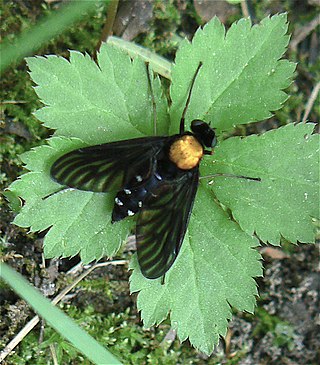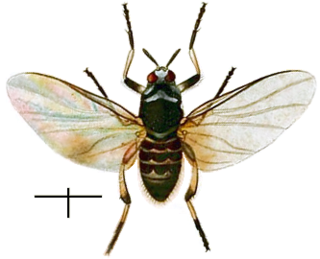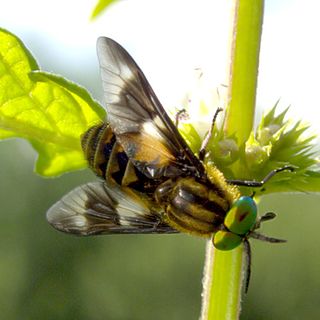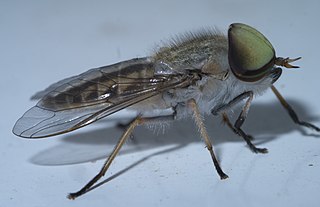Taxonomy
The taxonomy of the genus was revised in 1989 by an academic paper published in the bulletin of the American Museum of Natural History. [4] In 1997, researchers from the Universidad Nacional del Comahue in Rio Negro, Argentina collected larvae of G. marginalis and other fly species in Lanín National Park, Neuquén Province. After a close examination included chromosome mapping, they reported:
Females are not anthropophilic and can be found as well as in mountain creeks from sea level to 4,700 m of altitude (Wygodzinsky & Coscaron 1989). Gigantodax is a peculiar genus, showing the greatest diversity among the Prosimuliini genera, with synapomorphies in imago and preimaginal stages that help to differentiate species in this genus from other genera. The unusual morphology of the respiratory filaments in the pupal stage is useful in differentiating species. [1]
These South American researchers also analyzed G. marginalis , G. fulvescens , and G. chilensis and reported that Cnesia , another Prosimuliini genus, is sympatric with southern populations of Gigantodax and that both genera breed on both sides of the Andean range in Argentina and Chile in subantarctic Patagonia. They also reported that Gigantodax species in this area are also sympatric with Simulium . [1]
These genus was re-examined in 2007 by entomologists from the Universidade Federal do Rio de Janeiro in Brazil who explained that in their paper:
...the first phylogenetic hypothesis for the 13 Southern Hemisphere genera of Simuliidae is proposed, through a cladistic approach. In order to investigate the position of those genera representatives of five Northern Hemisphere genera were also included in the analyses as outgroups. The study was based on a data matrix with 33 terminal taxa and 119 morphological characters of adult, pupa and larva. The phylogenetic analysis under equal weights resulted in four most parsimonious trees, with similar topologies and 349 steps... [5]
Species
- G. antarcticus (Bigot, 1888)
- G. awa Wygodzinsky & Coscarón, 1989
- G. brophyi (Edwards, 1931)
- G. chilensis (Philippi, 1865)
- G. femineus (Edwards, 1931)
- G. flabellus Wygodzinsky & Coscarón, 1989
- G. kuscheli Wygodzinsky, 1952
- G. laevigatus Wygodzinsky & Coscarón, 1989
- G. luispenai Wygodzinsky & Coscarón, 1989
- G. marginalis (Edwards, 1931)
- G. multituberculatus Wygodzinsky & Coscarón, 1989
- G. ortizi Wygodzinsky, 1974
- G. osornorum Muñoz de Hoyos, Martínez, Mejía & Bueno, 1995
- G. paramorum Wygodzinsky & Coscarón, 1989
- G. patihuaycensis Wygodzinsky & Coscarón, 1989
- G. rufidulus Wygodzinsky & Coscarón, 1989
- G. trifidus Wygodzinsky & Coscarón, 1989
- G. viannamartinsi Ramírez-Pérez, 1980
- G. zumbahuae Wygodzinsky & Coscarón, 1989
- G. arrarteorum Wygodzinsky & Coscarón, 1989
- G. basinflatus Wygodzinsky & Coscarón, 1989
- G. cilicinus Wygodzinsky & Coscarón, 1989
- G. clandestinus Wygodzinsky & Coscarón, 1989
- G. destitutus Wygodzinsky & Coscarón, 1989
- G. fulvescens (Blanchard, 1852)
- G. incomitatus Wygodzinsky & Coscarón, 1989
- G. lazoi Takaoka, Hirai & Tada, 1988
- G. mariobordai Wygodzinsky & Coscarón, 1989
- G. pennipunctus Enderlein, 1934
- G. shannoni (Edwards, 1931)
- G. abalosi Wygodzinsky, 1958
- G. brevis Wygodzinsky & Coscarón, 1989
- G. cormonsi Wygodzinsky & Coscarón, 1989
- G. gracilis Wygodzinsky & Coscarón, 1989
- G. leonorum Wygodzinsky & Coscarón, 1989
- G. misitu Wygodzinsky & Coscarón, 1989
- G. praealtus Wygodzinsky & Coscarón, 1989
- G. siberianus Wygodzinsky & Coscarón, 1989
- G. vulcanius Wygodzinsky & Coscarón, 1989
- G. wygodzinskyi Moncada, Muñoz de Hoyos & Bueno, 1981
- G. adleri Moulton, 1996
- G. aquamarensis (De León, 1945)
- G. bettyae Wygodzinsky, 1974
- G. bierigi Vargas & Ramírez-Pérez, 1989
- G. cervicornis Wygodzinsky, 1974
- G. conviti Ramírez-Pérez, 1980
- G. corniculatus Wygodzinsky, 1974
- G. cypellus Wygodzinsky & Coscarón, 1989
- G. dryadicaudicis Wygodzinsky & Coscarón, 1989
- G. herreri Wygodzinsky & Coscarón, 1989
- G. horcotiani Wygodzinsky, 1949
- G. impossibilis Wygodzinsky, 1974
- G. incapucara Wygodzinsky & Coscarón, 1989
- G. nasutus Wygodzinsky & Coscarón, 1989
- G. rufescens (Edwards, 1931)
- G. septenarius Wygodzinsky & Coscarón, 1989
- G. willei Vargas & Ramírez-Pérez, 1989
- G. wrighti (Vargas, Martínez Palacios & Díaz Nájera, 1944)

Pipunculidae is a family of flies (Diptera) commonly termed big-headed flies, a reference to the large (holoptic) eyes, which cover nearly the entire head. The family is found worldwide and more than 1300 species have been described.

Chrysopilus is common, worldwide genus of predatory snipe flies. There are approximately 300 species in the genus, including fossil members that are sometimes found in amber.

The minute black scavenger flies or "dung midges", are a family, Scatopsidae, of nematoceran flies. Despite being distributed throughout the world, they form a small family with only around 250 described species in 27 genera, although many await description and doubtless even more await discovery. These are generally small, sometimes minute, dark flies, generally similar to black flies (Simuliidae), but usually lacking the humped thorax characteristic of that family.

Simulium is a genus of black flies, which may transmit diseases such as onchocerciasis.

The Richardiidae are a family of Diptera in the superfamily Tephritoidea.

Superfamily Tabanoidea are insects in the order Diptera.

Ochthera is a genus of flies in the family of shore flies (Ephydridae). The genus is distinctive because of the swollen raptorial forelegs. The larvae are predaceous on midge larvae while the adults feed on midges and mosquitoes. The genus is found around the world with about 37 species. The species Ochthera chalybescens has been shown to prey on African malaria vectors.

The Simuliini is a tribe of black flies that contains over 2,000 species, with more than 1,800 in the genus Simulium. There are 19 living genera, and three genera only known from Cretaceous fossils.
Prosimuliini is a tribe of black flies. It contains over 140 living species, with more than a half of them in the genus Prosimulium. There are 6 living genera, and 2 genera that are only known from Cretaceous fossils.
Cnesia is a genus of 4 species of black flies. They are distributed in Argentina and Chile.

Platystomatinae is a subfamily of flies (Diptera) in the family Platystomatidae that includes 80 genera, the largest subfamily with at last estimate, c. 900 species globally.

Tabaninae is a subfamily in the family Tabanidae commonly known as horse flies. There are more than 3000 described species in Tabaninae.

Diachlorini is a tribe of horse flies in the family Tabanidae.
Poeciloderas is a genus of horse flies in the family Tabanidae.
Pedrowygomyia is a genus of neotropical simuliid flies erected in 1998 from the Gigantodax cortesi species group of the 1925 genus Gigantodax after a cladistics analysis of the species groups recognized in the genus indicated that it was paraphyletic. The genus was named in recognition of the contributions to science of entomologist Petr Wolfgang Wygodzinsky. Pedrowygomyia originally comprised four species, P. cortesi, P. jatunchuspi, P. punapi and P. chacabamba, all described in 1989 from high-elevation areas in the Andean region. In 2020, a new species, P. hanaq, was described from the south-central Andes of Peru at an altitude above 4,000 m. Based on the pupal stage, the new species appears to be most closely related to P. punapi, a species known from Argentina, Bolivia, and Chile.

Pangoniinae is a subfamily of horse-flies in the order Diptera, containing at seven tribes and over 40 genera.
Fidena is a genus of horse-fly in the tribe Scionini.
Dicladocera is a genus of biting horseflies of the family Tabanidae.

Dasybasis is a genus of horse flies in the family Tabanidae.
This page is based on this
Wikipedia article Text is available under the
CC BY-SA 4.0 license; additional terms may apply.
Images, videos and audio are available under their respective licenses.













